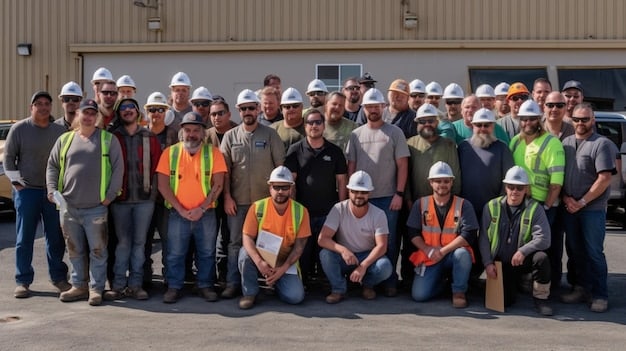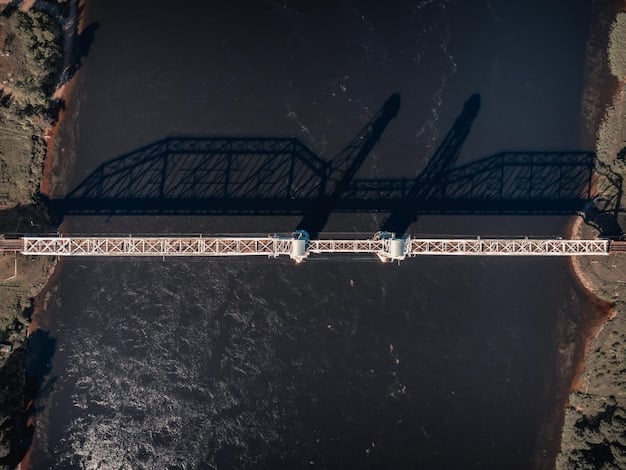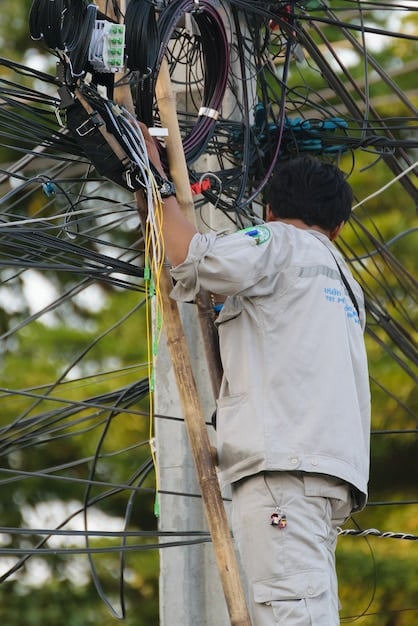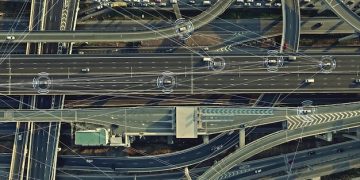Bipartisan Infrastructure Law: How It’s Creating 800,000 US Jobs

The Bipartisan Infrastructure Law is projected to generate approximately 800,000 new jobs across the United States by investing in crucial sectors like transportation, clean energy, and broadband internet, revitalizing the economy and boosting employment opportunities for American workers.
The Bipartisan Infrastructure Law is Creating 800,000 New Jobs in the US by modernizing infrastructure and stimulating economic growth, marking a significant opportunity for many Americans.
Unveiling the Bipartisan Infrastructure Law’s Job Creation Promise
The Bipartisan Infrastructure Law, signed into law, represents a substantial investment in America’s future, and the creation of new jobs. This initiative allocates funds to upgrade roads, bridges, public transit, water pipes, and broadband internet access, impacting the national economy and workforce.
The law’s primary goal is to modernize the country’s infrastructure, which deteriorates after years of neglect. By allocating resources towards these projects, lawmakers aim to improve safety, efficiency, and sustainability for future generations.
Key Sectors Driving Job Growth
The bipartisan infrastructure law targets several sectors to stimulate job creation. Here are key areas:
- Transportation: Investments in roads, bridges, and public transit will require construction workers, engineers, and project managers.
- Clean Energy: Funding for renewable energy projects, electric vehicle infrastructure, and grid modernization will create jobs in manufacturing, installation, and maintenance.
- Broadband Internet: Expanding internet access to rural areas necessitates technicians, engineers, and construction crews to lay fiber optic cables and build infrastructure.
These are examples of how the law’s investments will mobilize people and drive economic growth. Economists predict that it will have significant impact on people in the next decade.
In conclusion, the Bipartisan Infrastructure Law represents a strategic investment in the United States, creating jobs across important sectors driving economic growth.
How Transportation Projects Generate Employment
Transportation projects are a crucial component of the Bipartisan Infrastructure Law, creating jobs in construction, engineering, and related fields. These projects range from repairing roads and bridges to upgrading public transit systems, addressing the country’s extensive infrastructure needs.
The law allocates billions of dollars to modernize and expand transportation networks, thereby improving mobility and accessibility. These resources aim to enhance the efficiency and reliability of transportation across the country.

Specific Transportation Initiatives
Here are specific transportation initiatives that illustrate how the project generates employment:
- Road and Bridge Repair: Thousands of roads and bridges require maintenance, rehabilitation, or reconstruction, creating jobs for construction workers, heavy equipment operators, and engineers.
- Public Transit Expansion: Investments in buses, subways, and light rail systems will require manufacturing, maintenance, and operational staff, in addition to construction workers for new lines and stations.
- Airport Modernization: Upgrading airport infrastructure, including runways, terminals, and air traffic control systems, will generate jobs for electricians, mechanics, and technicians.
Investments in transportation infrastructure have significant effects, boosting economic activity. These projects improve the movement of goods and people, which drives economic growth and productivity.
In summary, transportation projects are important to modernize infrastructure in the United States. These initiatives contribute to economic growth by creating jobs and improving the efficiency of transportation networks.
Clean Energy Investments and Job Creation
The Bipartisan Infrastructure Law emphasizes investments in clean energy to support and stimulate job creation. This approach aligns with the growing need to mitigate climate change while fostering economic opportunities.
These investments seek to promote sustainable practices while growing new industries and job pathways. Transitioning to a cleaner energy infrastructure reduces emissions of greenhouse effect gases and drives economic growth.
Clean Energy Projects and Employment
The following projects reflect how the law will create employment:
- Renewable Energy Expansion: Construction of new solar, wind, and geothermal power plants will create jobs for installers, technicians, and engineers.
- Electric Vehicle Infrastructure: Installing charging stations across the nation requires electricians, technicians, and construction workers, reducing dependence on fossil fuels.
- Grid Modernization: Upgrading the electrical grid to transmit renewable energy more efficiently involves engineers, technicians, and project managers.
These initiatives have many effects, advancing new industries, and reducing carbon emissions. Investments in clean energy will create a more robust and sustainable economy for future generations.
In summary, clean energy investments are an essential component of the Bipartisan Infrastructure Law. These initiatives create job opportunities, promote environmental sustainability, and ensure long-term economic prosperity.
Expanding Broadband Access and Job Opportunities
Expanding broadband internet access to underserved communities is a key goal of the Bipartisan Infrastructure Law, which also generates opportunities for new opportunities and economic development. This initiative aims to bridge the digital divide, providing all Americans with access to vital resources and opportunities.
Broadband access has become necessary for success in today’s economy, for education, healthcare, and employment. By investing in broadband infrastructure, the law increases opportunities for communities that were previously left out.
Benefits of Broadband Expansion
Here’s a summary of benefits that show how broadband expansion helps the job sector:
- Construction Jobs: Installing fiber optic cables and building broadband infrastructure creates jobs for technicians, engineers, and construction crews.
- Remote Work Opportunities: Improved internet access enables remote work, opening new job opportunities for people in rural areas.
- Economic Development: Broadband expansion attracts businesses and investments to underserved areas, stimulating economic growth and job creation.
Overall, these factors are an economic driver, helping build better equity and access to resources.

In conclusion, broadband expansion is more than just technological advancement, addressing issues of equity, economic development and growth. Increasing access to digital resources helps people prosper in the modern, connected, world.
The Ripple Effect: Indirect Job Creation
Beyond the direct jobs created by infrastructure projects, the Bipartisan Infrastructure Law generates a ripple effect throughout the economy, spurring indirect job creation in various sectors. This multiplier effect amplifies the law’s economic impact, leading to broader prosperity.
Indirect job creation arises from the increased demand for goods and services needed to support infrastructure projects. As projects proceed, additional industries and workforces benefit.
Examples of Indirect Job Creation:
- Manufacturing: Increased demand for construction materials, equipment, and vehicles boosts manufacturing activity and employment.
- Services: Increased spending by construction workers and related personnel supports the retail, hospitality, and healthcare sectors.
- Technology: Development and implementation of new technologies for infrastructure projects create jobs for software developers, engineers, and data analysts.
The indirect job creation ensures the law will benefit the long-term economy. It creates better economic resilience while expanding job opportunities in a variety of industries.
In summary, the Bipartisan Infrastructure law unleashes powerful forces, building a framework for sustainable economic growth.
Challenges and Opportunities in Workforce Development
While the Bipartisan Infrastructure Law holds immense potential for job creation, successful implementation requires addressing challenges in workforce development. Ensuring that workers have the skills and training needed to fill these new positions is crucial for maximizing the law’s impact.
Workforce development programs are necessary to bridge the gap between available jobs and qualified workers. These initiatives equip individuals with the knowledge and skills needed to succeed in the country’s growing economy.
Workforce Development Strategies:
- Training Programs: Increased funding for vocational training and apprenticeship programs will prepare workers for jobs in construction, clean energy, and broadband infrastructure.
- Community Colleges: Partnerships between community colleges and industry leaders will provide targeted training programs aligned with workforce needs.
- Recruitment and Outreach: Efforts to recruit and support workers from underserved communities will ensure that the benefits of the infrastructure law are shared equitably.
By addressing these changes, policymakers can make certain that everyone can play a role in strengthening the nation’s infrastructure.
By empowering more workforces and investing in better education and equity, the country will be better positioned to face future challenges.
| Key Point | Brief Description |
|---|---|
| 🛠️ Infrastructure Upgrade | Modernizing roads, bridges, and public transit. |
| ⚡ Clean Energy Jobs | Creating jobs in renewable energy and EV infrastructure. |
| 🌐 Broadband Expansion | Extending internet access and boosting tech jobs. |
| 🔄 Ripple Effect | Indirect job creation in manufacturing and services. |
Frequently Asked Questions (FAQ)
▼
The Bipartisan Infrastructure Law is expected to create approximately 800,000 new jobs across the United States. These jobs will be in sectors such as construction, clean energy, and technology.
▼
The sectors that will benefit the most include transportation, with road and bridge repairs, clean energy with renewable projects, and broadband internet expansion bringing tech jobs to rural areas.
▼
The government is funding vocational training and apprenticeship programs, and has partnered with community colleges to offer programs tailored to the needs of the new jobs created by the law.
▼
The law focuses on recruiting and supporting workers from underserved communities, ensuring that the job opportunities are accessible to everyone. These outreach efforts help to distribute benefits fairly.
▼
Yes, there are opportunities for small businesses to get involved in various infrastructure projects. Small businesses can provide goods and services, further contributing to job creation and economic growth.
Conclusion
In conclusion, the Bipartisan Infrastructure Law represents a transformative investment in both the US economy and future, with the potential to create approximately 800,000 jobs. By modernizing transportation, expanding clean energy, and broadening internet access, this law delivers vital infrastructure upgrades and prepares the workforce. Although challenges remain, strategic workforce development and inclusive recruitment practices could help maximize these opportunities and ensure prosperity for all Americans.





